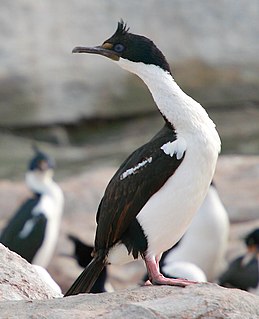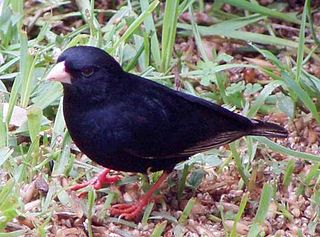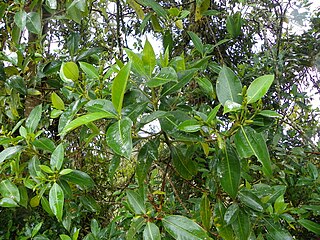
Cyclamen is a genus of 23 species of perennial flowering plants in the family Primulaceae. Cyclamen species are native to Europe and the Mediterranean Basin east to the Caucasus and Iran, with one species in Somalia. They grow from tubers and are valued for their flowers with upswept petals and variably patterned leaves.

The green honeycreeper is a small bird in the tanager family. It is found in the tropical New World from southern Mexico south to Brazil, and on Trinidad. It is the only member of the genus Chlorophanes.

The red-legged honeycreeper is a small songbird species in the tanager family (Thraupidae). It is found in the tropical New World from southern Mexico south to Peru, Bolivia and central Brazil, Trinidad and Tobago, and on Cuba, where possibly introduced. It is also rarely found in southern Texas.

The blue dacnis or turquoise honeycreeper is a small passerine bird. This member of the tanager family is found from Nicaragua to Panama, on Trinidad, and in South America south to Bolivia and northern Argentina. It is widespread and often common, especially in parts of its South American range.

The crested guan is a member of an ancient group of birds of the family Cracidae, which are related to the Australasian megapodes or mound builders (Megapodiidae). It is found in the Neotropics, in lowlands forests ranging from south Mexico and the Yucatán Peninsula to western Ecuador and southern Venezuela. The sexes are similar in appearance; the plumage is mainly dark brown with white spotting, an area of bare skin round the eye, bright red wattles, a bushy crest, a long broad tail and pink legs. It is a social bird, often seen in pairs or small family groups. It feeds in trees, mainly on fruit, and builds a nest of twigs on a branch. The two or three white eggs are incubated by the female. The International Union for Conservation of Nature has rated this bird's conservation status as "Near Threatened".

Ptisana purpurascens is a large fern belonging to the botanical family Marattiaceae. It has a globular rhizome with stipule-like fleshy outgrowths. The leaves are dark green, twice pinnate and up to 1 metre long. Every pinnule has up to six pairs of leaflets. The petioles are dark-purplish, hence the name 'purpurascens' meaning 'becoming purple'. The sporangia are fused in all Ptisana into a bivalvate synangium.

The imperial shag or imperial cormorant is a black and white cormorant native to southern South America, primarily in rocky coastal regions, but locally also at large inland lakes. Some taxonomic authorities, including the International Ornithologists' Union, place it in the genus Leucocarbo, others in the genus Phalacrocorax. It is also known as the blue-eyed shag, blue-eyed cormorant and by many other names, and is one of a larger group of cormorants called blue-eyed shags. The taxonomy is very complex, and several former subspecies are often considered separate species.

Dalbergia purpurascens is a species of legume in the family Fabaceae.

Butia purpurascens is a smallish, relatively slender, endangered species of Butia palm, up to 3-7m tall. It is locally known as palmeira-jataí, coqueiro-de-vassoura, butiá or coquinho-azedo in Portuguese. The Kalunga people call this palm cabeçudo.

The dusky indigobird, variable indigobird, or black widowfinch is a species of bird in the family Viduidae. It is found in Angola, Burundi, Cameroon, Republic of the Congo, Democratic Republic of the Congo, Eswatini, Guinea-Bissau, Malawi, Mozambique, Nigeria, Sierra Leone, South Africa, Tanzania, Zambia, and Zimbabwe. Its natural habitat is moist savanna.

The purple indigobird is a species of bird in the family Viduidae. It is also known as the dusky indigobird, a name which can refer to Vidua funerea. It is found in Angola, Botswana, Democratic Republic of the Congo, Kenya, Malawi, Mozambique, South Africa, Tanzania, Zambia, and Zimbabwe. Its natural habitat is dry savanna.
Aegiphila purpurascens is a species of tree in the family Lamiaceae. It is endemic to Azuay Province in Ecuador, where only three populations are known. It grows in the cloud forests of the Andes at 2000 to 3000 meters in elevation.
Hedyosmum burgerianum is a species of plant in the Chloranthaceae family. It is endemic to Panama. It is threatened by habitat loss. Originates in Panama, confined to a narrow altitudinal range between 1,500 and 1,900 m. The populations are large in certain places. The species of plant is named after William Carl Burger, who has made valuable contributions to the study of this genus.

Hedyosmum is a genus of flowering plants in the family Chloranthaceae. There are about 40 to 45 species. They are distributed in Central and South America and the West Indies, and one species also occurs in southeastern Asia. They are mostly dioecious, except for H. nutans and H. brenesii which are exclusively monoecious, and H. scaberrimum and H. costaricense with both monoecious and dioecious individuals.

Hedyosmum mexicanum is a species of plant in the family Chloranthaceae. It is found in Guatemala and Mexico. It is threatened by habitat loss.
Keetia purpurascens is a species of flowering plants in the family Rubiaceae. It is endemic to Tanzania.
Metastelma purpurascens is a species of plant in the family Apocynaceae. It is endemic to Ecuador. Its natural habitat is subtropical or tropical moist montane forests. It is threatened by habitat loss.

Hygrophorus purpurascens, commonly known as the veiled purple hygrophorus, is a species of agaric fungus in the family Hygrophoraceae. Its cap has a pink background color with streaks of purplish red overlaid, and mature gills have red spots.

The brown kukri snake is a species of snake of the family Colubridae.
The purplish dtella is a species of gecko endemic to Australia.















